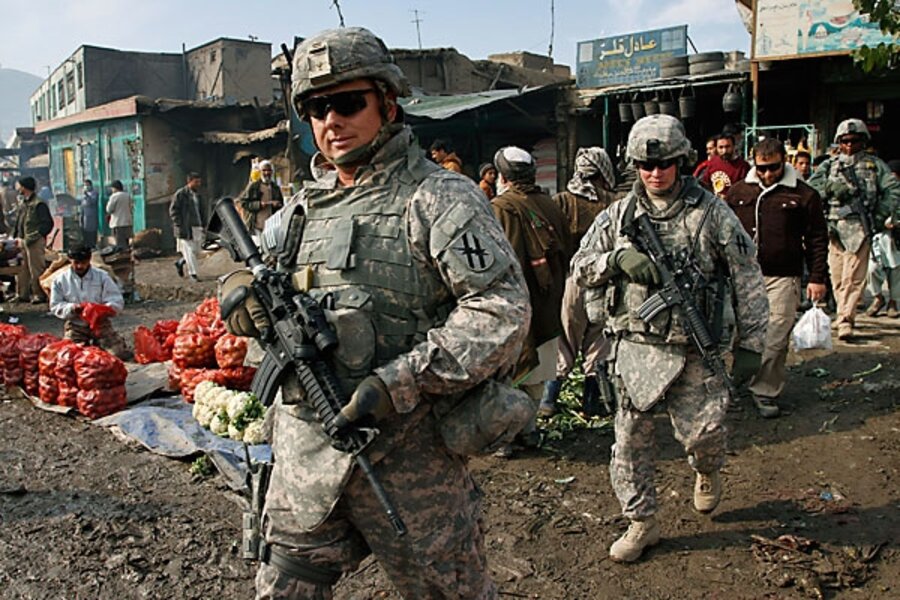Obama's Afghanistan war plan: How will he pay for it?
Loading...
| Washington
President Obama’s new strategy for Afghanistan may succeed. It may fail. But one thing is sure: It will cost $30 billion a year that at the moment the Pentagon doesn’t have.
As of now, Congress appears poised to just borrow the cash to pay for the deployment of 30,000 more US troops to Afghanistan, adding to the federal deficit. That’s in contrast to healthcare reform, which lawmakers are struggling to pay for with tax increases and budget cuts.
This shows that years of special supplemental appropriations to pay for the Iraq and Afghan wars have made it too easy for lawmakers to avoid making tough fiscal choices on defense, say some deficit hawks.
“Deeming a particular initiative as vital to the national interest should not exempt it from being paid for,” said Maya MacGuineas, president of the Committee for a Responsible Federal Budget.
No payment plan spelled out
In his speech Tuesday night, Mr. Obama himself noted that the cost of his Afghan troop increase would run about $30 billion a year.
“I’ll work closely with Congress to address these costs as we work to bring down our deficit,” said Obama.
But the president gave no specifics as to what addressing those costs might mean.
It is probably too late for Congress to consider the extra Afghan expenses this year. Lawmakers are close to final approval of the Department of Defense spending bill for fiscal year 2010, which already includes $130 billion for next year’s Afghanistan and Iraqi operations.
That means the most likely option is for the House and Senate to take up a $30 billion supplemental appropriation for Afghanistan sometime after they return from their holiday break. During the Bush administration, annual costs of the Iraqi and Afghan conflicts largely were funded via such supplementals.
From the left, a push for a war tax
Some liberal Democrats who oppose Obama’s new war strategy have vowed to try to enact a war tax to pay for at least part of this extra cost.
Otherwise, the longer-term costs of continuing conflict in the Afghanistan region could “devour virtually any other priorities that the president or anyone in Congress [has],” said Rep. David Obey (D) of Wisconsin, chairman of the House Appropriations Committee and a war-tax supporter.
But House and Senate Democratic leaders – as well as many Republicans – have sounded less than enthusiastic about a new Afghan-related levy. Instead, key Democrats have said they will try to fund the war effort without raising taxes during an economic downturn. Like the president, they have been vague about what that funding effort might entail.
Given that 2010 is an election year, the war-tax effort is doomed from the start, and its proponents know that, says Gordon Adams, Office of Management and Budget associate director for national security during the Clinton administration. They may be just trying to make a point about their opposition to the new Afghanistan strategy.
Finding places to cut elsewhere in the federal budget and offset the new war costs will be difficult, because the 2010 budget was drawn up long ago, adds Mr. Adams.
So, how will Congress ultimately pay for the Afghan spending?
"Yeah, they'll borrow it," says Adams, a professor of international relations at the American University and co-author of a new book on defense budgeting.
$1 trillion and counting
Meanwhile, the new spending seems set to push the total cost of the Afghanistan and Iraqi wars over the $1 trillion mark, according to the Congressional Research Service.
While the larger Iraq war has been more expensive overall, the Afghan conflict is much more expensive on a per-soldier basis, according to an analysis from the Center for Strategic and Budgetary Assessments.
Over the past five years, the cost per troop in Iraq has been about $556,000 per year, while the same figure for Afghanistan has been $1.1 million, according to CSBA.
The differential might be explained by the economies of scale inherent in the larger forces in Iraq, said CSBA analyst Todd Harrison. It might also be due to the longer and more difficult-to-traverse supply lines of the Afghan conflict.
The cost of fuel is one of the most expensive aspects of maintaining deployed forces in the region. Due to fuel-gulping weapons and bases, each soldier in Iraq and Afghanistan needs about 8,000 gallons of fuel per year. Due to the need to protect fuel convoys with heavy security, the delivered cost of fuel in the region is from $25 to $45 per gallon.
“Fuel costs alone make up some $200-350 thousand of the cost per troop per year,” writes Todd Harrison in a new analysis of estimated Afghanistan funding.
----
See also:
Obama's lonely road in Afghanistan
How Obama's speech sounded to Afghans
Obama's Afghanistan timeline adheres to McChyrstal's assessment
----
Follow us on Twitter.





